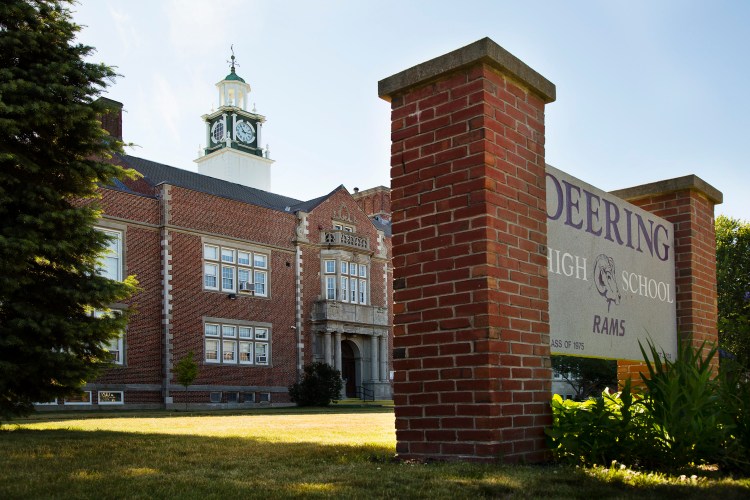Portland’s elementary and middle schools are operating at a healthy capacity, but the high schools are “empty,” with far fewer students than the buildings were designed to hold, according to a consultant hired by the city’s school district.
That, along with new five-year demographic projections being unveiled Monday, are key considerations for a 16-member committee charged with finding cost-cutting opportunities for Portland’s public schools.
Recommendations from the committee to the superintendent are due in the next two months, and are meant to help the Board of Education and City Council work through what will likely be a difficult budget season.
Maine is aging and has declining numbers of young people, driving down enrollment from kindergarten through higher education. But Portland’s K-12 demographics have fluctuated as the economy shifted and immigrants arrived. The school district currently has 6,768 students for the 2018-19 school year, down 2 percent over 10 years from the 6,916 student enrollment in 2008-09. Statewide student enrollment over the same period is down 5 percent.
But even with declining numbers of K-12 students, the district may need more elementary school space to accommodate its growing pre-K program, which currently serves 116 4-year-olds. The school board has passed a resolution committing to expanding the program, and state officials, including Gov. Janet Mills, have said early education and universal pre-K are top education priorities for the state.
In some districts, consolidation has left schools with little space to offer pre-K.
The capacity analysis found that the elementary and middle schools are in the normal range, as is Casco Bay High School, according to consultant Jon Thomas, president of Thomas & Williamson Program Management in Pittsburgh.
But Portland and Deering high schools are both largely “empty” – operating at 46 and 63 percent, respectively.
Thomas said the general rule of thumb for an appropriate level of school capacity is about 85 percent for elementary schools, 50 to 60 percent for middle schools and 90 percent for high schools. Overall, the elementary schools are running at 78 percent, the middle schools are at 50.5 percent, and the high schools are operating at 55 percent.
Thomas told the committee that there is a great deal of underutilized space in the high schools.
“That’s really very low,” he told the committee about the figures. Casco Bay High School is “OK,” running at about 70 percent, he said, because it has a nontraditional format that uses space differently from a traditional high school.
The committee’s goal, officials say, is to find ways to reduce costs, a response to several years of bruising school budgets and the expectation that there will be even less state education funding available in the future as Portland’s property valuation increases.
In recent years, budget tensions have soared as higher school budgets required regular tax hikes, with the local impact compounded as Portland’s higher property valuation triggered a decrease in state education funding. That local tax burden is expected to increase in future years as Portland’s property valuation continues to rise. The district makes estimates about future state funding, but it is a volatile figure that regularly fluctuates by millions of dollars as the Legislature and governor make changes to the formula.
Last year, the school board could not get council support for several budget proposals and wound up cutting school days and reducing funds for programs to reach agreement on a $110.6 million school budget that increased the school portion of the tax rate by 5 percent.
During that debate, the idea of cutting costs by closing a school was raised – alarming parents but going nowhere because there were not good data to support an informed conversation and not enough time to do the research in time to affect the current budget cycle. That led school board leaders to pledge to do that research after the last budget cycle.
Now a 16-member commission is sifting through the data to come up with recommendations. So far, they have been in what Chairman Peter Eglinton calls “fact-finding” mode – getting capacity information from consultant Thomas and a fresh five-year demographics projection from Davis Demographics.
The committee will use that information, along with discussions about programming and transportation costs, to send recommendations to Superintendent Xavier Botana within the next month. Among the elements the committee will consider are reorganizing academic grades, such as creating a K-8 program, or relocating offices or programs to reduce the district’s overall physical footprint.
Botana told the committee in December that the district is holding off on signing a new lease for the Portland Adult Education program and plans to close the Bayside program at its current location and redistribute all the students to other Portland locations, including at least two schools.
In addition to schools, the district has several other facilities, including:
• Administration offices and the Bayside School, both housed in a three-story building downtown with entrances on both Cumberland Avenue and Portland Street. The 50,000-square-foot building – the old Goodwill building – was purchased and renovated for $3.6 million in 2013.
• A transportation hub, located on the grounds of the PATHS/Casco Bay High School property.
• Adult education programs located in leased space – paying $540,000 for a three-year lease – at the Cathedral School on Locust Street.
• A central kitchen facility at 92 Waldron Way, in a 21,250-square-foot building purchased for $3.2 million in 2013.
The Portland school district made several changes to its facilities in 2013.
At the time, the administrative offices were at Casco Bay High School, and the Bayside program – known then as the West program – was in a short-term lease in Falmouth after the district had to close the West School in Portland because of the building’s failing condition. The district’s adult ed program was also housed in the West School, and was relocated to the Cathedral School location.
Noel K. Gallagher can be contacted at 791-6387 or at:
Twitter: noelinmaine
Send questions/comments to the editors.



